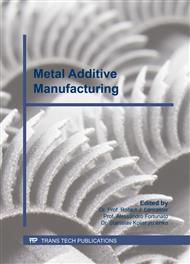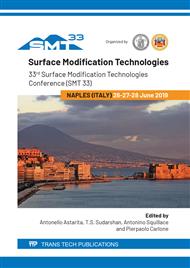[1]
C.R. Cunningham, J.M. Flynn, A. Shokrani, V. Dhokia, S.T. Newman, Invited review article: Strategies and processes for high quality wire arc additive manufacturing, Addit. Manuf. 22 (2018) 672–686.
DOI: 10.1016/j.addma.2018.06.020
Google Scholar
[2]
G. Campatelli, F. Montevecchi, G. Venturini, G. Ingarao, P.C. Priarone, Integrated WAAM-Subtractive Versus Pure Subtractive Manufacturing Approaches: An Energy Efficiency Comparison, Int. J. Precis. Eng. Manuf. Technol. (2019).
DOI: 10.1007/s40684-019-00071-y
Google Scholar
[3]
B. Wu, D. Ding, Z. Pan, D. Cuiuri, H. Li, J. Han, Z. Fei, Effects of heat accumulation on the arc characteristics and metal transfer behavior in Wire Arc Additive Manufacturing of Ti6Al4V, J. Mater. Process. Technol. 250 (2017) 304–312.
DOI: 10.1016/j.jmatprotec.2017.07.037
Google Scholar
[4]
J. Ge, J. Lin, Y. Lei, H. Fu, Location-related thermal history, microstructure, and mechanical properties of arc additively manufactured 2Cr13 steel using cold metal transfer welding, Mater. Sci. Eng. A. 715 (2018) 144–153.
DOI: 10.1016/j.msea.2017.12.076
Google Scholar
[5]
J.F. Wang, Q.J. Sun, H. Wang, J.P. Liu, J.C. Feng, Effect of location on microstructure and mechanical properties of additive layer manufactured Inconel 625 using gas tungsten arc welding, Mater. Sci. Eng. A. 676 (2016) 395–405.
DOI: 10.1016/j.msea.2016.09.015
Google Scholar
[6]
D. Ding, Z. Pan, D. Cuiuri, H. Li, Wire-feed additive manufacturing of metal components: technologies, developments and future interests, Int. J. Adv. Manuf. Technol. 81 (2015) 465–481.
DOI: 10.1007/s00170-015-7077-3
Google Scholar
[7]
J. Xiong, Y. Li, R. Li, Z. Yin, Influences of process parameters on surface roughness of multi-layer single-pass thin-walled parts in GMAW-based additive manufacturing, J. Mater. Process. Technol. 252 (2018) 128–136.
DOI: 10.1016/j.jmatprotec.2017.09.020
Google Scholar
[8]
F. Montevecchi, G. Venturini, N. Grossi, A. Scippa, G. Campatelli, Idle time selection for wire-arc additive manufacturing: A finite element-based technique, Addit. Manuf. 21 (2018) 479–486.
DOI: 10.1016/j.addma.2018.01.007
Google Scholar
[9]
Y. Lei, J. Xiong, R. Li, Effect of inter layer idle time on thermal behavior for multi-layer single-pass thin-walled parts in GMAW-based additive manufacturing, Int. J. Adv. Manuf. Technol. 96 (2018) 1355–1365.
DOI: 10.1007/s00170-018-1699-1
Google Scholar
[10]
H. Takagi, T. Abe, P. Cui, H. Sasahara, Mechanical Properties Evaluation of Metal Components Repaired by Direct Metal Lamination, Key Eng. Mater. 656–657 (2015) 440–445.
DOI: 10.4028/www.scientific.net/kem.656-657.440
Google Scholar
[11]
F. Li, S. Chen, J. Shi, Y. Zhao, H. Tian, Thermoelectric Cooling-Aided Bead Geometry Regulation in Wire and Arc-Based Additive Manufacturing of Thin-Walled Structures, Appl. Sci. 8 (2018) 207.
DOI: 10.3390/app8020207
Google Scholar
[12]
D. Ding, D. Cuiuri, B. Wu, H. Li, Z. Pan, Z. Fei, The effects of forced interpass cooling on the material properties of wire arc additively manufactured Ti6Al4V alloy, J. Mater. Process. Technol. 258 (2018) 97–105.
DOI: 10.1016/j.jmatprotec.2018.03.024
Google Scholar
[13]
F. Montevecchi, G. Venturini, N. Grossi, A. Scippa, G. Campatelli, Heat accumulation prevention in Wire-Arc-Additive-Manufacturing using air jet impingement, Manuf. Lett. 17 (2018) 14–18.
DOI: 10.1016/j.mfglet.2018.06.004
Google Scholar
[14]
T.S. O'Donovan, D.B. Murray, Jet impingement heat transfer - Part I: Mean and root-mean-square heat transfer and velocity distributions, Int. J. Heat Mass Transf. 50 (2007) 3291–3301.
DOI: 10.1016/j.ijheatmasstransfer.2007.01.044
Google Scholar
[15]
R.J. Goldstein, M.E. Franchett, Heat Transfer From a Flat Surface to an Oblique Impinging Jet, J. Heat Transfer. 110 (1988) 84.
DOI: 10.1115/1.3250477
Google Scholar
[16]
S. Jhavar, N.K. Jain, C.P. Paul, Development of micro-plasma transferred arc (μ-PTA) wire deposition process for additive layer manufacturing applications, J. Mater. Process. Technol. 214 (2014) 1102–1110.
DOI: 10.1016/j.jmatprotec.2013.12.016
Google Scholar
[17]
A. Lundbäck, L.E. Lindgren, Modelling of metal deposition, Finite Elem. Anal. Des. 47 (2011) 1169–1177.
Google Scholar



